Excerpts from Jim Conrad's
Naturalist Newsletter
from the December 21, 2014 Newsletter issued from Río Lagartos, on the Yucatan Peninsula's northern coast (~N21.60°, ~W88.16°), Yucatán state, MÉXICO
WIDGEONGRASS
I'd never seen the estuary's water so low, thanks to an especially low tide. Vast acreages of what's usually open water now was brown, leafy aquatic vegetation waiting for the tide to return. As our flamingo-viewing boat positioned for a better look at a big crocodile, I could see that in the shallow water next to the boat the bed was thickly mantled with grass-like vegetation. Plants retrieved from the water were weakly rooted to the floor, and out of the water looked like nothing more than wet crabgrass. You can see the tangled mess below:
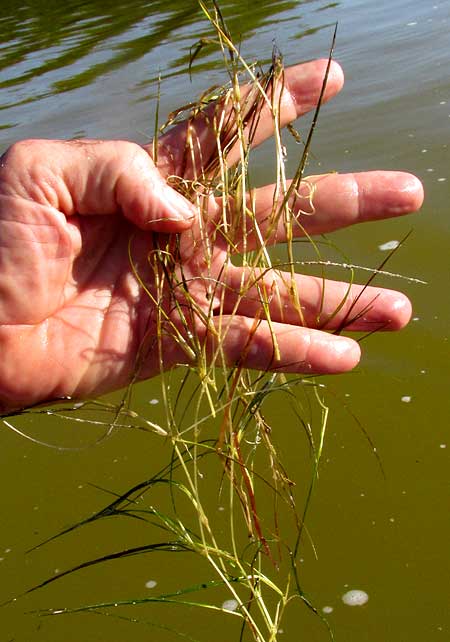
A close look reveals certain features pointing to its identity. For example, one stem bore what's shown below:
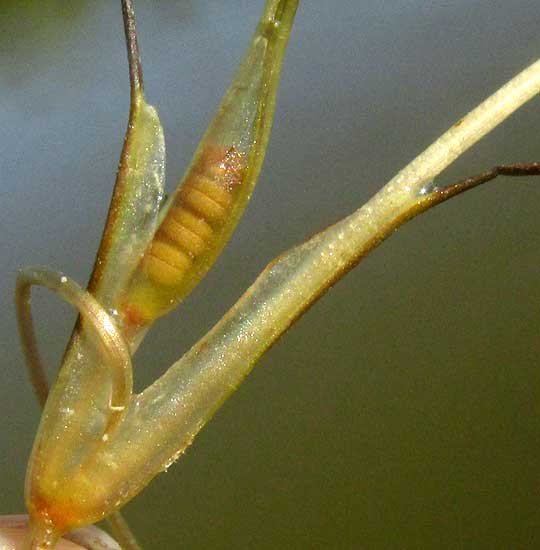
That shows a stem and a flower emerging from between wrap-around "sheathes" flaring at the bottom of two wiry leaves. The flower looks like four stacked hamburger buns inside a long, pointy bladder. The bladder is formed by undeveloped leaf sheathes of unexpanded leaves that later will spread above the flower. The flower bears two stamens, each stamen with two anthers, all four anthers in a line and looking like they're split across their middles, which is the fracture line where the anther will split to release pollen. Through the bladdery sheathes we can't see the female parts but they're there.
Once the flower is pollinated, the stem, or "peduncle," below it elongates and the spent anthers fall away. Below, you can see ovaries of pollinated flowers on a fast-lengthening peduncle:
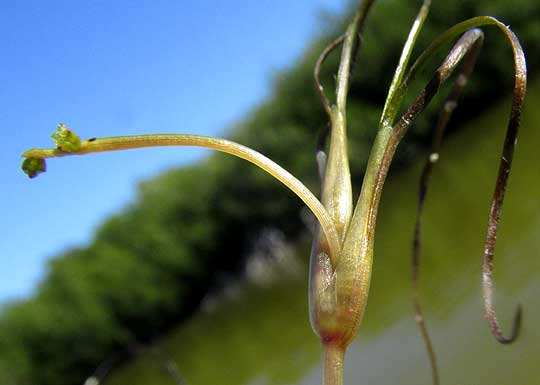
The peduncle lengthens considerably. I read that eventually it curls until it forms up to five coils, but ours only makes a weak effort at one coil -- maybe because the fruits aren't yet mature -- as you can see below:
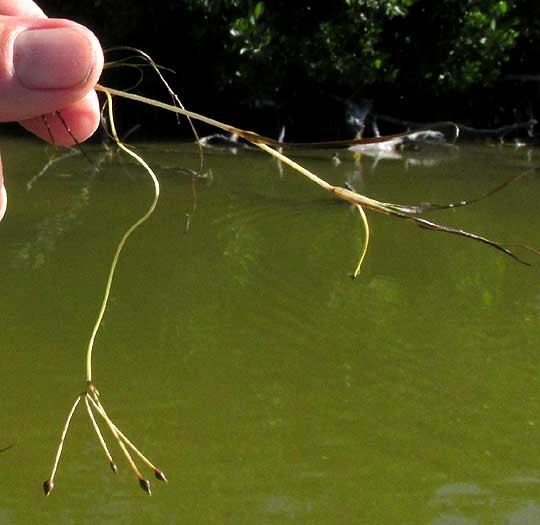
A close-up of two immature fruits appears below:
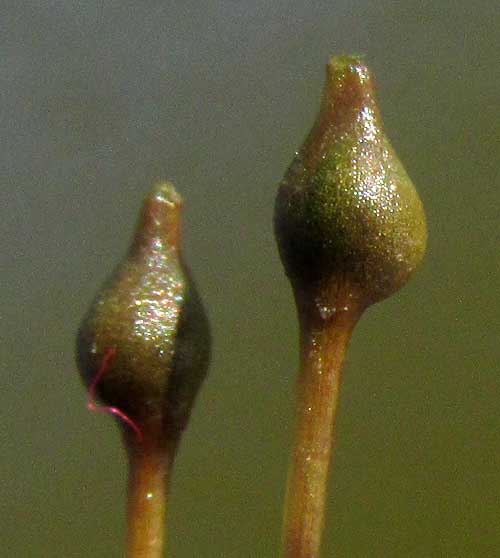
This plant, usually called Widgeongrass but also Ditchgrass, is RUPPIA MARITIMA, found in shallow waters of brackish streams, lagoons, estuaries, ditches, and lakes along ocean shores practically worldwide, except in the polar zone. It's a monocotyledonous plant like grasses, lilies and orchids. Despite the "grass" part of its common names it isn't a member of the Grass Family but rather belongs to its own family, the Widgeongrass Family, the Ruppiaceae. The Widgeongrass Family is a small one embracing only one genus and about ten species, all growing submersed in brackish or saline waters, or fresh waters with very high calcium or sulfur ion concentrations.
I was especially tickled to meet this plant because in recent Newsletters we've been looking at the extremely important seagrasses that form dense underwater prairies offshore here and in the estuary. Seagrasses hold the sea or lagoon floor in place with their roots, and provide food and protective cover for untold numbers of aquatic animals. In this area ecologist list four main seagrass species. So far we've profiled three of those, and now this Widgeongrass is our fourth. The other three are Manatee-grass, Turtlegrass and Shoal Grass. You can review these under our "Aquatic" section at www.backyardnature.net/yucatan/seashore.htm.
Widgeongrass, despite its species name of "marina," is best described as a salt-tolerant freshwater species. The plant often self-pollinates, but the flowers also release pollen that reaches other plants by floating away on bubbles. The drupelet-type fruits -- drupelets being a part of an aggregate fruit such as raspberries and blackberries -- are dispersed inside the guts of fish and waterbirds that eat them. The plant also reproduces vegetatively by sprouting from its rhizome to form colonies.
Widgeongrass is so important to aquatic habitats such as our Ría Lagartos Estuary that in many cases wetland restoration begins with the recovery and protection of this plant.